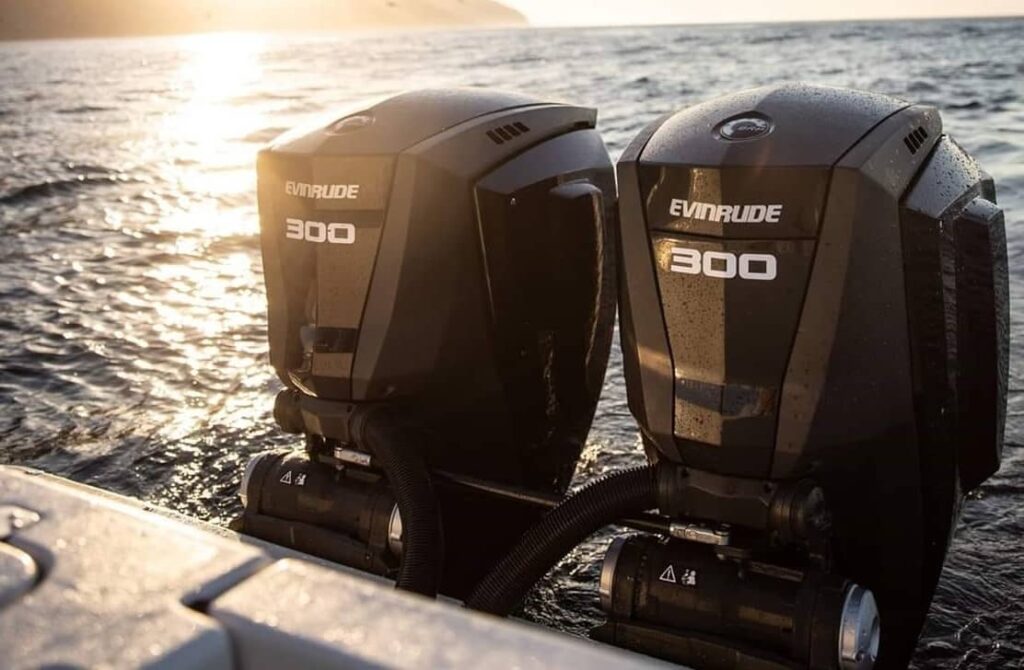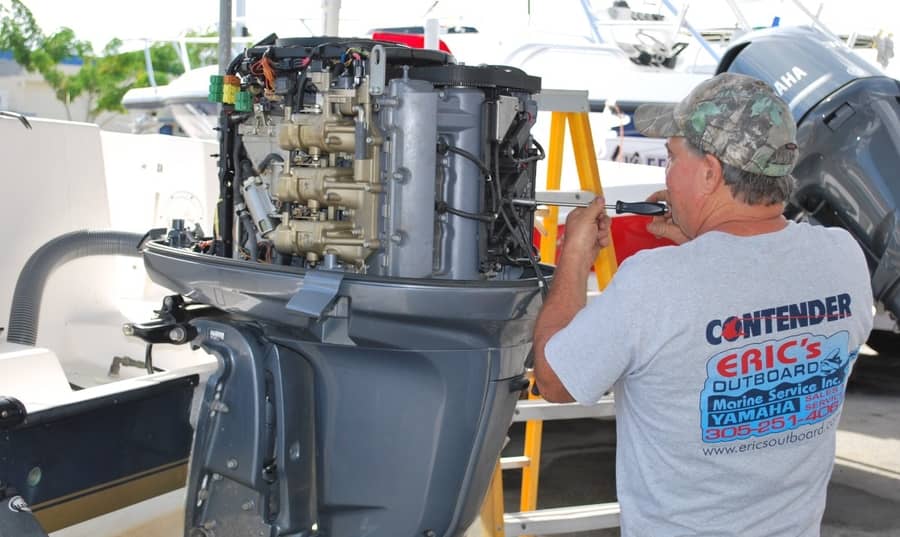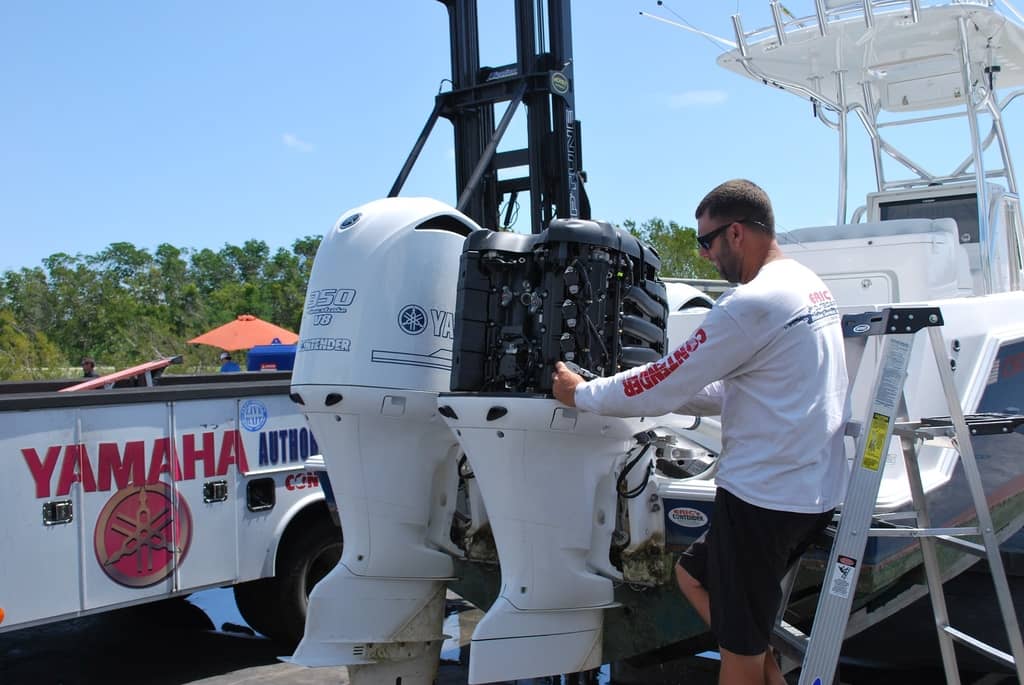Common Outboard Marine Engine Issues and How to Fix Them
For many sailboats, outboard motors are an excellent choice. They’re simple to fix and maintain, can be easily relocated between boats, and can be improved in a short period of time. However, they, like all automobiles, have their share of problems. These issues might require an easy repair or a more complicated one in order to fix them. In this article, I will give you a list of some of the most common outboard issues and how you can fix them. If you’re interested, keep reading!
The Motor Doesn’t Start
Anyone who has ever turned a key in the ignition understands how frustrating it is to hear nothing. This is almost certainly an electrical problem, such as a low or dead battery, or a break in the ignition circuit. There are a number of potential reasons why the engine won’t start. It’s possible that your battery is dead or that your spark plugs are moist and can’t ignite. It could be a problem with your gasoline source, your ignition, or the starter itself. Based on the noises your engine makes or doesn’t make, most trained experts can tell you what the problem is in a matter of minutes.
How to Fix It
Firstly, you should check the kill switch. Ensure that the shifter is in the neutral position. After that, check the starter switch as well. Note that the dash-mounted ignition switch can become loose in its fitting and allow the entire switch mechanism to revolve with the key. It’s as easy as getting under the dash and tightening a retention nut in order to fix this. It could be a low battery, but it could also be a loose or bad connection if the starter moans but won’t engage. You’ll need insulated screwdrivers, a wrench set, and Allen wrenches. It’s also a good idea to have a battery charger on hand.
Tip: You should check and clean your wiring on a regular basis and repair it when necessary. Consider installing a secondary battery bank or one of those metering systems that check supply and save enough reserve to ensure a restart in case you need it.
Spark Plugs Issue When the Motor Doesn’t Start
When things go wrong, being aware will aid you in the troubleshooting process. What precisely is your motor doing if it won’t start? To run, engines require three things: air, spark, and fuel. Is it able to run but then sputter out and die? Because the motor did operate for a second, this would indicate that it is receiving air and spark. The fuel phase of your troubleshooting would then be initiated.
How to Fix It
If it won’t start at all, there could be a problem with the spark plugs, which are frequently missed because everyone assumes the battery is to blame. You should change your spark plugs on a regular basis; if you haven’t done so in a while, it’s almost probably the cause of the problem. You should also examine the spark plug for wear and tear. A working spark plug should be dry and grey; if it is black, the engine has too much oil, and if it is white, the engine is overheating. If it’s not completely dry, this could indicate that there’s water in the fuel. In this case, I’d suggest getting in a spark plug tester.

>>Also Read: How to Winterize an Outboard Motor
Running Out of Gas
The most common cause of sailors becoming stranded on the water is not correctly calculating the amount of gas needed. So, keep in mind to should double-check your boat’s fuel gauge in order to see if you have enough. Furthermore, knowing a little bit about your boat’s fuel burn and operating range will be practical as you won’t have to face this issue. Knowledge is the key!
How to Fix It
Always make sure before you set sail to fill up the tank and double-check that your fuel gauge is accurate. Plan to utilize one-third of your fuel supply to go out for the day, one-third to return, and one-third in reserve. This is in case of poor weather, strong seas, fog, or other unforeseen situations that might cause you to stay on the sea longer than intended.
Fuel Line Issue
It is possible for the engine to have fuel inside but not being able to start. Because many quick-disconnect connections that link the fuel line to the outboard are just cheap, this tends to happen frequently. This can also happen to the barbs that connect the fitting and the fuel line, as well as the hose clamps that secure them. All of these connections tend to leak or enable air to get sucked in overtime.
How to Fix It
Squeeze the ball while keeping an eye on the fitting between the engine and the line, the barb and the hose, the barb on either end of the ball, and the fitting between the line and the tank, if it’s visible. The leak must be isolated and sealed. If there’s no obvious fuel leak, the ball could be sucking in the air. So, press it repeatedly while listening for a gurgle adjacent to each connection. After isolating the leak, you may be able to repair it by cutting a segment of the fuel line and reattaching the barb or fitting it with a new piece of hose or simply replacing a hose clamp. You can sometimes push the fitting to one side or the other to get the engine running again if it has gone bad. Once you’ve done that, the engine’s draw is often enough to keep the fuel flowing.

Flooded Engine
It’s also possible that the engine could be flooded. Note that there is too much gas in a flooded engine, and not enough of it is atomizing to combust. This frequently occurs as a result of multiple efforts to start with the choke or primer. You can close the choke and open the throttle to half or more when attempting to start the flooded engine. Give it a couple of attempts, and if it still doesn’t work, wait about ten minutes and try again. Some motors are extremely vulnerable to flooding, while others are not affected at all.
How to Fix It
If you’ve checked everything and are certain the engine isn’t flooded, getting a can of starting fluid is a sure-fire approach to narrow down your troubleshooting. Remove the cowling from the engine and squirt a little amount of fluid into the air intake. You want it to go straight into the manifold, if possible. Then start the engine. If it starts briefly and then runs out of starting fluid, you can be sure the issue is with your fuel system.
Tell-Tale Issue
It is possible for the tell-tale not to be able to spit water. This could be the result of a damaged water pump impeller, which will need to be replaced. The problem usually occurs when the tell-tale is clogged with grit, sludge, or a piece of seaweed that the engine picked up. However, note that if you don’t know what’s causing the problem, you’ll have to tow the boat to the technician.
How to Fix It
From the outside in, ream the tell-tale. As long as you have some fishing line on hand, this is a lot easier than it sounds. Choose the widest diameter line that will fit through the little tell-tale hole and thread it as far as you can. Then, between two fingers, spin the line. Try to work it in further as you whirl. Pull the line out and start the engine after you’re sure it won’t go any further. If there is still no flow after three or four tries, blame the impeller and call it a day. But, more often than not, the tell-tale will start spouting water again after this repair.
Dead Battery
Troubleshooting your battery is similar to troubleshooting an automobile if your motor has an electric starter. It’s possible that the battery is dead if you turn the key and only hear a clicking. Examine the obvious causes. Boats should be equipped with two batteries, one of which should be isolated from the rest of the boat so that it can maintain its charge in order to start the motor. Lights and bilge pumps might deplete both batteries if the switch is placed incorrectly.
How to Fix It
If the motor has been slow to start recently, or if it spins over more slowly than usual, it could be a sign of a fading or dead battery. To start it, try using your other battery or getting a jump from another vessel. If you’re on land, connect your battery charger and give it a shot. It’s time to search elsewhere if the motor cranks with the same power as it always does but won’t start.
Overheating Issue
This is a regular issue with outboard boat engines. If your engine is liquid-cooled, you may be running low on oil or coolant. The majority of the time, something is obstructing the passage of water through the water inlet. Bear in mind that water must flow through outboard motors at all times to keep them cool, or else problems can emerge. Also, note that the water that the boat is riding on cools the outboard engines. They don’t have radiators like automobiles. The most common cause of this issue is anything blocking the water intake valve. This debris, which could be mud or rubbish, should be scraped out of the motor.
How to Fix It
The problem is almost often an impediment in the raw water input, such as weeds, mud, or a plastic bag. So, you should locate it and clean out the intake. Water flow can be slowed by a slack hose clamp or a burst hose, which can spray damaging moisture around the engine. It’s advantageous to have wire onboard to assist with cleaning. It’s also possible that a loose or broken hose or clamp has to be replaced. Lastly, note that you should frequently check the impeller and exhaust system of the motor. Periodic maintenance, in addition to ensuring that the coolant reservoir is full, is essential.
Tip: Make sure to check the exhaust system for corrosion or blockage. Have the exhaust risers and associated components inspected on a regular basis.

>>Also Read: Best and Most Reliable Marine Engines for Boats
Loss of Power and Sputtering
If your engine is sputtering, you will lose engine power. This is due to a failure in the fuel delivery system or a compression problem. If your engine is carbureted, it might be a clogged fuel line, filter, or jet that creates the issue. If the issue isn’t caused by a lack of compression, you may require new piston rings, or you might be dealing with something more serious. It’s possible that you purchased a faulty load of fuel, but it’s more likely that the fuel became contaminated while in your boat. Condensation and water in the gas can occur if a tank is left near empty for an extended period of time.
How to Fix It
The solution is to remove the in-line fuel filter and replace it. If you don’t have one, you can at least clear any debris from the filter element and drain any water it has. Moreover, you should completely vent the engine compartment before restarting. If you don’t, a blocked filter won’t be your biggest issue. If the problem isn’t with the gas, it could be with the spark plugs. This is a more typical issue with older outboard engines, but it’s worth checking on any engine.
You can fill the tank for long-term storage, and use a fuel stabilizer if the storage time is longer than three months. If this is the case, make sure you run the boat long enough for the gas to enter the engine. Note that debris can be at the bottom of older tanks, which can be churned up as the fuel level declines. Increased filtration may be the best answer. Consider replacing the stock gasoline filter with a larger aftermarket fuel filter.
The Engine Shuts Down and Won’t Restart
Did you check the ball in the fuel line and see that it had collapsed when you tried to squeeze it in? The collapsed ball indicates a lack of capacity to draw, which is frequently caused by an obstruction in the fuel tank vent.
How to Fix It
First and foremost, check to determine if you have a portable fuel tank with a screw-type vent. It’s astonishing how often people overlook this vent, just to discover that it’s closed. When you open the screw, the engine should start right up. If you’re on a boat with a tank, make sure the vent is working properly. Mud wasps are frequently the source of this problem. They crawl up the vent, make a nest, and turn off the power. By reaming the vent out, you can make them leave the nest. But, be prepared to go away as soon as possible; they will be annoyed! Lastly, check your fuel filters a week or two later, since they may have gathered up some of the nest’s debris.
The Engine Cranks
This could happen for a variety of reasons. Firstly, make sure the shifter is in neutral, but if it doesn’t even try to catch, your emergency cut-off switch is probably malfunctioning. It makes it appear as if the lanyard clip has been removed, preventing the engine from starting. This is a particularly prevalent and bothersome problem if the switch is installed horizontally in a location where water can pool on it and cause damage. In order to fix this you should turn off the emergency kill switch. Take a look at the wiring at the rear of the switch panel. The black one with the yellow stripe is the one you’re looking for. Disconnect it and try the key again; chances are the engine will start straight up.
The Engine Stalls in Neutral
The cause of this is most likely a sticky or faulty AIS (automatic idle speed) valve. This applies in case your outboard starts right up, stays running with throttle applied in neutral, then shuts down the instant you return to idle speed in neutral. This valve regulates air intake to manage idle speed, and if it gets stuck in the wrong position, it can shut you down cold.
How to Fix It
You have two options in order to fix this issue: clean the valve or replace it. Replacing it is better because if the valve breaks, it usually tends to become stuck again at some point. This isn’t a difficult task, but most people will want their mechanic to do it. In the meanwhile, you can save time by starting in neutral with the throttle slightly forward and bringing it back as near to idle as possible without actually going into idle. Most of the time, you’ll be rotating around 700 RPM. Then, without any hesitation or halt, move to idle and then to forward. It may take a few tries, but you can put the engine forward while it’s still running if you do it quickly enough. And, there will be no issue once it is in gear and running (throughout the RPM range). Just keep in mind that if you shift back into neutral, the engine will cut out once more. And, obviously, shifting this quickly is bad on the engine. It’s fine to do it once or twice to save the day, but have that valve serviced before taking the boat out again.

>>Also Read: Sailing vs Cruising: What is the Difference?
Carburetor Issues
Carburetors’ small nozzles and tubes become blocked with containments, especially if the fuel is poor or has been sitting for a long time. Ethanol fuels exacerbate these issues. Taking the carb off and cleaning it out on portable outboards isn’t a difficult task. But, it’s probably better to hire a professional if your engine has more than one carburetor. Before diving into the task at hand, take a brief glance at the motor’s shop manual and parts schematics. If the process appears to be too difficult for you, consider getting the help of a mechanic.
How to Fix It
The plastic air intake, fuel line, and throttle linkage should all be removed before cleaning a carburetor. Drain the float bowl at the bottom of the carb after securing the fuel line. The carburetor is held in place by a few long bolts that are simple to remove, thus the whole unit should come apart. If you don’t have a spare gasket, be careful not to damage the one between the carb and the manifold. Transfer to a clean workbench or a location where you won’t lose small parts. One screw holds the float bowl in place, after which you should be able to remove the float and needle.
The main jet, which is the nozzle that suctions fuel from the float bowl and sprays it into the venturi throat, should now be accessible. Soak the little pieces, especially the tiny jets, in carb cleaner in a small jar. The more time you give it to soak, the better. It is preferable to stay overnight. Clean the rest of the carb, giving special attention to the tiny channels near the venturi throat and butterfly valve. You should maintain a clean and dust-free environment. Reassemble and replace the carburetor the next morning. Make sure the idle and mixture adjustment screws aren’t turned. Hopefully, your outboard motor will be able to start up.
Vibration from the Prop
Keep in mind that the vibrations become worse the faster you try to go. You may also see that the motor is racing as the boat slows down. In this case, the prop is most likely malfunctioning. A cut or gouge in the blade can cause vibration, a towrope might snag the shaft, and a direct collision on an item can remove enough metal to render the prop useless. Note that even if a prop appears to be in good condition, it may have enough undetected distortion or damage to induce cavitation and vibration. Short of switching to a spare prop, which isn’t always easy or advisable when on the water, your best bet is to slow down and focus on getting to shore.
How to Fix It
If the line has worked its way into the prop hub, especially monofilament, you may need to trim the motor until you can remove the prop and clear it out. Most outboards and I/Os can handle a little mono, but if there’s enough to cause a perceptible drop in performance, don’t overlook it; it could cause irreparable harm. The rubber bushing inside the hub of outboards might begin to slip and fail, resulting in a loss of power. Consider bringing a spare prop along with the tools you’ll need to swap it out.

Drive Belt Issue
Over the usual engine noise, you won’t hear a drive belt breaking. But, you’ll know something’s wrong when the overheat warning light comes on or your voltage meter revealing that the alternator isn’t charging. Note that a broken belt can quickly shut you down. You won’t have an alternator or a water pump if the belt is broken. There’s a lot of information online on making a makeshift belt out of a fishing line, pantyhose, or other materials. However, it’s better to just carry a spare and the tools to change it.
Common Outboard Marine Motor Issues and How to Fix Them – Final Thoughts
Whether we’re talking about the now-common four-stroke or DFI motors, modern outboard engines have gone a long way. In all situations, reliability is significantly greater than it was decades ago, fuel efficiency has improved, and many issues no longer occur. However, this does not imply that your outboard is without flaws. In truth, the above-mentioned issues are the most common ones that occur with modern outboard motors. I hope that this article gave you adequate information and a solution to your problem, see you soon!
